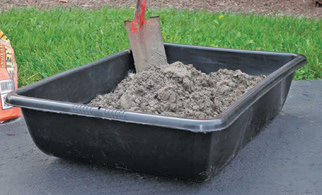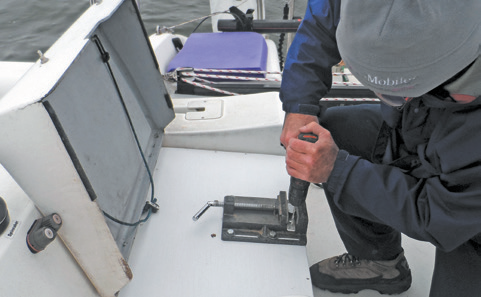So you’ve got a locker full of tools and materials and the skills to take on anything. But what do you work on? Spill a can of paint, lose a small part, or slam a hammer into the deck and the collateral damage outweighs all of the good you’ve done. How do you hold a small part firmly while drilling or filing? Although I have the space for an elaborate workroom at home, space and weight are critical on a boat. Though you can haul some work back to the home shop, we need portable solutions for everyday use.
Working Surfaces
There are three parts to this problem; on the boat, on the dock, and when the boat is on the hard.
On the Water Few sailors want to dedicate space for a shop, and normally the best place to work is where the project is, so the work surface must be mobile. Food service trays are perfect for painting, fiberglass work, minor bangs, and catching small parts while rebuilding carbs and winches. They are indestructible and compact, and can even be scrubbed off and used to clean fish! A fenderboard can be lashed down across the cockpit. A hole in one end that fits over or around a winch helps stabilize it.

uses, rightside up or upside down.
In the Water. For heavy duty job like rebuilding a self-steering windvane or lower unit on an outboard, a concrete mixing tub with a small line tied to holes into corners is the trick. The tray easily supported a couple of lower units and all of the heavy tools used to pull them.
The lines secured the tray from floating away. The tray catches tools and fasteners. For smaller jobs, like adjusting a bobstay, working on a through hull, or replacing zincs, a litter box size tray is enough and can serve double duty as a dishwashing tray or small part tray on deck. Again, drill small holes in the corner and length of light line keep it handy. A type-III PFD eliminates treading water.
At the Dock. When real grinding, cutting, or banging are required, I don’t want to do that on the boat, no matter what the bench. I move to the dock and lay down a protective bit of plywood fitted with a few bench stops to secure the work. Underside stops keep it on the dock. I’m sure it could be made fancy, according to the reader’s imagination and needs. Keeps the dockmaster from having a cow.
On the Hard Time for some serious work. While a card table or a pair of saw horses and a sheet of plywood can do well, I like the Black and Decker Workmate 450. Very sturdy, clamps well, and covered with a towel, makes a nice general purpose table.
Clamping
Work surfaces can incorporate cleats or holes for this purpose, but sometimes more specific clamping measures are required.
Clamp-on vise Unless you have a very sturdy table to clamp this to, with an edge you don’t mind scarring, the larger sizes aren’t practical. We carried a small clamp-on vice on two boats for 20 years, and I can remember a single job where it was critically useful. A machinists vice must be through bolted to be of much use.
Drill Press Vise Although more limited in terms of what they can hold, drill press vises have the major advantage of being useful without being bolted to anything. For drilling or filing small parts they can often be used without being secured at all.
The disadvantages are that they are shallow, not as good for bending rods and strips, and less versatile when holding odd shapes.
C-Clamps and Vice Grips. The clamps can keep plywood work surfaces in place and prevent larger projects from moving. Vice grips are surprisingly versatile as a minimal vice, even better when a helper is available.
Portable Benches. An elevated work surface that avoids being bent over all day is a blessing for larger projects. Add a clamping function and they can be darn handy for working on rudders, cabinetry, and larger parts.
Beware of leaving many of these in the elements; they have particle board tops, which although plenty strong, will warp if left in the rain. A passing shower is harmless, but don’t let it become a habit.
On the Boat
Food Service Tray. Perfect for painting, fiberglass work, minor bangs, and catching small parts. Great for rebuilding carbs, winches, and holding the varnish can. Indestructible and compact. Can also be scrubbed off and used to clean fish! $2.50.
Bottom Line: One of the Best Buys on the boat.
Fender Board. A mandatory accessory for cruisers that go far or more to pilings, they can also be used to lash jerry cans to the stanchions or as a surface to cut and pound on. A good reason to stay simple, with pressure treated lumber or red cedar. About $5-10.
Bottom line: Fender Boards are Recommended for mooring to pilings and for projects.
In the Water
Concrete Mixing Tub. Sized to hold 29 gallons of concrete, these are rugged and can easily support 75 pounds of tools and parts. A dinghy can work, but it’s really hard to reach over the side. About $12 at any home improvement center.
Bottom Line: Handy for big in-water jobs.
Dishwashing tray or Litter Box. Good for smaller jobs, like changing a prop or cleaning the bottom. $3-$5.
Bottom Line: Recommended, because you need a dishwashing tray anyway.
On the Hard

carpet on the bottom can be used for a variety of onboard projects. The Black and Decker workmate
series benches (below), collapses and can provide a handy platform for boatyard work. Just don’t leave it out in the rain.
Workmate 450, Black and Decker. I’ve gone through three of these, over 30 years of hard use. They aren’t industrial grade, and leaving them in the rain or running the clamps in too tight takes a toll. On the other hand, they fold in moments, are quite stable, and with an extra board inserted they make good work tables. The wide clamp holds larger wood working projects, and the bench stops. There is also a lighter duty model—the Workmate 250—but In my mind, if I’m going to lug a bench, I want the 450.
Bottom line Recommended for home and boat yard use.
Grizzly Mini-Bench. A baby cousin of the Workmate, I’ve seen this table top version on a number of boats, including some full-time cruising friends. They found it useful when working on projects, but eventually gave it to a beginning cruiser when their projects were finished. They felt OK about this, since they had been given it by another cruiser who had finished his move-in projects.
Bottom line: We can recommend it as useful, but whether it is worth the space on-board depends on the size of the boat and the work you are doing.
Drill Press Vice, 4-inch. My home shops has a heavy 6-inch machinist’s vice, bolted to an even heavier bench, bolted to the wall. I use it to bend thick metal and to hold things while cutting. I use it more often than the drill press vice, but as I think about it, often it is just a matter of convenience and where it is located.
If the job requires precision drilling of small parts, I reach for the drill press vice, even when I’m not using the press; it holds the parts better. Because it lies flat, there is very little leverage and I often use it without securing it down at all.
Bottom line: More useful than a bench vice if you don’t have a heavy bench to bolt it to.
Conclusions
My cafeteria tray shows the scars of hundreds of uses. I’ve banged on fender boards, laid sheets of plywood on the dock, and wedged work against pilings. Precision drilling or working on engine parts might include both the cafeteria tray and my lazarette cover vice. For large project on the hard, my Workmate 450 comes with me. A good work surface and clamps can be just as important as what’s in your tool box.
BLACK AND DECKER, www.blackanddecker.com
GRIZZLY, www.grizzly.com


































I saw a fellow using an upside down umbrella, to catch small parts and tools etc. I built a six foot bench, sitting not work, and use it for all sorts of projects, It’s nothing fancy so I don’t care if it gets dinged or covered in paint,. You can clamp to it cut things etc and you don’t have bend over very far..
The upside down umbrella is a really cool idea, particularly for working on outboard motors. A 6 foot bench would be a real luxury on a boat. In my comment there is a YouTube link to a guy who made a dismantling bench out of his saloon pipe cot, and that is such an awesome use of existing features. I bought a Bosch PDB40 drill press and am modifying it extensively to fit into my 930mm wide work space. I was able to incorporate the sewing machine by opening access into an adjacent void to slide the machine away into and cover with a drop in panel.